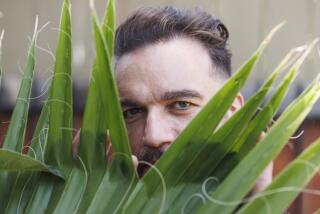A Lush, Calm Urban Secret -- Soon to Be Declassified
- Share via
When you least expect it -- and perhaps most need it -- the underground garden pops out of nowhere in the center of the busy city.
The James Irvine Garden has both startled and soothed passersby in the Little Tokyo section of Los Angeles for 23 years.
A wall of coast redwoods framed by Japanese black pine trees separates it from a high-rise next door. A small waterfall tumbles into two streams that meander beneath crepe myrtle and willow trees, past a glen of glistening bamboo and under graceful wooden footbridges.
It’s a quiet and gentle refuge from urban stress. And it sometimes is all but invisible to people just a few steps away.
“It’s one of L.A.’s hidden surprises, one of the less-than-obvious features that give a city its true character,” said Armando Ruiz, a retirement planner from the mid-Wilshire area who was eating lunch nearby this week.
A friend eating with Ruiz was oblivious to it. What garden? the perplexed man asked.
The carefully landscaped oasis is tucked in an 8,500-square-foot triangle beneath a plaza at the Japanese American Cultural & Community Center at 244 S. San Pedro St.
A sense of solitude and tranquillity was one of the things Japanese-born landscape architect Takeo Uesugi was looking for when he sketched out the garden in the late 1970s.
Drawing from a tradition of Japanese garden-making dating to 1040, Uesugi arranged earth, rocks, water and plants in asymmetrical fashion to create a setting that was dynamic but at the same time humble.
“He created it as a reminder of where we as Japanese Americans came from,” said Robert Hori, a cultural center executive. Subtle symbols are everywhere in the garden.
The 170-foot stream, which forms two channels, flows through more than a century of Japanese American history.
“We came from Japan. But there’s a deeper story there,” Hori said. “The waterfall represents hardships encountered by immigrants -- and is a reminder that we all are immigrants. There’s a turbulent side of the stream, and it represents the war years and the turbulent experience many Japanese Americans went through during the war.
“Farther down, the stream is quieter. There are two forks in the stream, but everything comes together in a peaceful melting pot at the end.”
Uesugi drew inspiration for the garden from visits to Mt. Baldy. That’s also where he got 250 tons of granite boulders for it. Plants found locally are blended with bamboo, Japanese maple and other traditional landscape elements.
Rocks and boulders throughout the garden, along with the gravel walkway and cobblestones, create a strong, solid look. Lush growth from patches of various grasses, shrubs and Japanese wisteria offer up a delicate, living counterpoint.
The garden gets its name from the James Irvine Foundation, which contributed more than half of its $400,000 cost. More than 200 volunteers -- many from top Los Angeles-area nursery and landscape companies that donated much of the vegetation -- spent nearly a year of Sundays laboring to hand-craft the garden.
The project was a major event for local Japanese Americans, many of whom are Japan-born, first-generation Issei immigrants. Cultural center officials recall that elderly pensioners on fixed incomes at the nearby Little Tokyo Towers would come over and press $20 bills into the sweaty volunteers’ hands so they could buy refreshments.
A year after opening, the garden began attracting attention. The American Assn. of Nurserymen gave its National Landscape Award to the garden in 1981 in a White House ceremony led by First Lady Nancy Reagan.
These days, garden lovers are awaiting the first blooms of its azaleas. Their February bursts signal the approaching springtime, when the secret oasis is at its brilliant, colorful best.
And leaders of the Japanese American Cultural & Community Center are anticipating a growth spurt of their own.
A planned $15-million expansion and renovation of the center will include construction of an elevated terrace for a better view of the sunken garden. The project -- scheduled to begin in 2004 when first-phase funding is secured -- also will include a new garden gateway.
The garden, with no admission charge and open from 9 a.m. to 5 p.m. daily except holidays, is now reached through a basement corridor in the center’s headquarters building. That can be confusing to passersby who notice it but figure it’s closed to the public.
“I saw the garden on a map and knew it was here. But I had to ask a man to tell me how to get to it,” said Cecilia Salgado, a tourist from Mexico City who spent time this week strolling along its gravel walkways.
Kathryn Doi Todd, a board member for the center for more than 20 years who heads a panel planning the expansion, said officials want to raise the sunken garden’s profile.
“The goal is to make it more accessible” and easier for visitors to linger, said Todd, an associate justice with the federal Court of Appeals in Los Angeles.
“The cobblestones are not easy to walk on. The paths are not straight. You can’t run through the garden. A Japanese garden reflects nature in a miniature form. It’s a place to enjoy a spot of serenity in downtown Los Angeles. But there are many people who don’t know it’s here, and that’s regrettable.”
So, for a while longer, the James Irvine Garden is like a private refuge for those in the know.
“It’s a hidden treasure,” said visitor Pat Reid, a claims agent who lives in Long Beach. “Standing in the middle of the garden, you don’t feel like you’re standing in the middle of L.A.”
To see video of the James Irvine Garden, go to www.latimes .com/surroundings.







